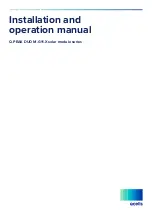
4 Maintenance and care
3
Installation manual
Conergy
ENGL
ISH
3.3.3 Parallel and serial connection
Solar modules of the same type can be connected in parallel. The
solar modules in this series are fundamentally designed for series
connection.
3.3.4 Connecting solar module
On the rear of the solar module, there is a connection box with the
connection cables, the plug and the socket.
3.3.5 Earthing
The earthing requirements must be checked in accordance with the
applicable regulations and standards before work is started.
The positions of the earthing holes are shown in Fig. 3–1.
Example: Use of a hexagon bolt from above
Fig. 3–2:
Guide hexagon bolt into earthing hole from above
4
Maintenance and care
The solar modules are low-maintenance modules. However, Con-
ergy recommend that a visual inspection of the mechanical and
electrical connections be performed once a year to detect any dam-
age.
Dirt on the solar modules reduces the output and the yield. If the
solar modules are installed with an inclination angle of more than
15°, they will generally be adequately cleaned by the rain.
5
Removal
1.
Disconnect the inverter from the supply network on the AC side
so that the photovoltaic system has no load.
2.
Disconnect the photovoltaic system from the inverter at the cut-
off point on the DC side.
3.
Make sure that the system is not supplied with voltage.
4.
Remove the photovoltaic system in the same way as it was in-
stalled; observe the safety instructions.
6
Disposal
Do not dispose of old or defective solar modules with normal house-
hold waste.
Please ask your installer, dealer or Conergy AG about disposal.
Material damage due to connection errors.
|
Only use solar modules of the same type and output
for parallel connection. Take measures for overcurrent
protection (e.g. line fuse) if necessary. Never exceed
the specified reverse current loadability of the solar
modules.
|
Make sure that only solar modules with the same am-
perage (Impp) are interconnected for series connec-
tion and make sure that the voltages of lines
connected in parallel are the same. Even at low tem-
peratures, never exceed the maximum permissible
system voltage of the solar modules.
|
Make sure that the number and connection of the solar
modules match the electrical values specified by the
devices connected to the photovoltaic system.
|
Make sure that the polarity is correct.
Connection cable length
mm
Connection cable cross section
mm
2
Allowable ambient temperature range for
cables
from
°C
to
°C
The earthing cable can be mounted on one of the two
holes in the module frame (see Fig. 3–1).
Avoid contact corrosion when using different metals and
observe electro-chemical insulation rating.
As an option, stainless-steel terminals with pins can also
be used for earthing the solar modules, which penetrate
the anodised layer of the module frame during installa-
tion. These stainless-steel terminals are available
together with earthing terminals (for the connection of
the installation frame to the earth) from the manufac-
turer.
Observe the applicable regulations.
Use a suitable stainless-steel bolt
(4)
together with a
stainless-steel spring lock washer
(5)
(between bolt
head and module frame
(6)
), a self-cutting stainless-
steel serrated lock washer
(7)
(between ring terminal
end
(8)
and module frame
(6)
), a suitable ring terminal
end
(8)
and a suitable nut
(9)
.
(9)
(4)
(5)
(6)
(7)
(8)
Damage to the solar module surface by
scratching or extreme differences in temper-
ature.
|
Only use pH neutral liquid cleaner, even if there is ex-
cessive dirt build-up.
|
Do not use cleaning agents with abrasive constituents.
|
Only use cleaning solutions that are at roughly the
same temperature as the solar module surface.
|
Wipe the solar module surface with water and a soft
cloth.
|
Never attempt to rub or scratch off dirt particles.
Risk of electric shock.
|
Do not touch any bare connection parts.
|
Only use insulated tools.
Conergy reserves the right to make changes to this
installation manual without prior notice.
1000
4.0
-40.0
+120.0
PH 180-200M









































